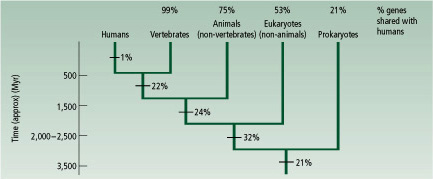Evolutionary genomics - How has the human gene set built up over evolutionary time?

If we have the complete genomic sequences of several species, we can use them to see which genes are unique to each species, and which genes are shared with other species. Given a phylogeny of the species, we can infer how the gene set of a species evolved over time.
For example, about 21% of human genes are shared with all cellular life forms, and a further 32% of genes are shared with all other eukaryotes. These 50% or so of human genes are mainly the “housekeeping” genes of our cells. About 24% of our genes are shared only with other animals. These include genes, such as the Hox genes, that code for development. About 22% of our genes are shared only with other vertebrates; these include many genes concerned with the nervous and immune systems.
Further research may reveal more exactly where it was in our ancestry that each of our genes first arose. The origin of particular genes and gene sets may be associated with evolutionary events in the past.
| Next |



